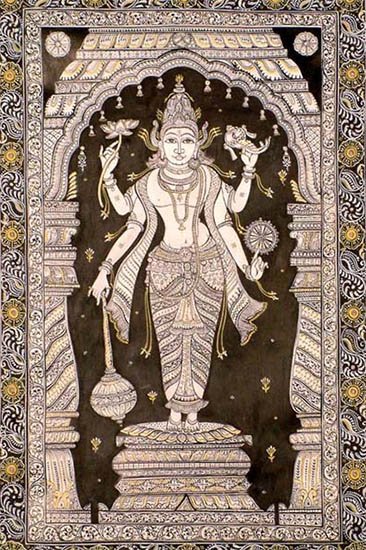Citrarasa, Citra-rasa: 2 definitions
Introduction:
Citrarasa means something in Hinduism, Sanskrit, Jainism, Prakrit. If you want to know the exact meaning, history, etymology or English translation of this term then check out the descriptions on this page. Add your comment or reference to a book if you want to contribute to this summary article.
Alternative spellings of this word include Chitrarasa.
In Hinduism
Shilpashastra (iconography)
Source: Shodhganga: Elements of Art and Architecture in the Trtiyakhanda of the Visnudharmottarapurana (shilpa)Citrarasa (चित्ररस) refers to the “nine sentiments” in ancient Indian Painting (citra), according to the Viṣṇudharmottarapurāṇa, an ancient Sanskrit text which (being encyclopedic in nature) deals with a variety of cultural topics such as arts, architecture, music, grammar and astronomy.—Painting is a medium of showing the inner feelings and emotions of a painter which can strikes the inherent sentiments of connoisseur’s mind. Through a Painting, a painter is seen to express different sentiments. According to the Viṣṇudharmottarapurāṇa nine kinds of sentiments are reflected through Paintings and these are termed as citrarasas in this work.
These nine kinds of citrarasas are—
- śṛṅgāra i.e., erotic,
- hāsya i.e., humour,
- karuṇa i.e., pathos,
- raudra i.e., furious,
- vīra i.e., heroic,
- bhayānaka i.e., terrible,
- adbhuta i.e., wonder,
- bībhatsa i.e., odious and
- śānta i.e., quietism.

Shilpashastra (शिल्पशास्त्र, śilpaśāstra) represents the ancient Indian science (shastra) of creative arts (shilpa) such as sculpture, iconography and painting. Closely related to Vastushastra (architecture), they often share the same literature.
In Jainism
General definition (in Jainism)
Source: archive.org: TrisastisalakapurusacaritraCitrarasa (चित्ररस) refers to one of the ten kinds of wishing-trees (kalpa), according to chapter 1.1 [ādīśvara-caritra] of Hemacandra’s 11th century Triṣaṣṭiśalākāpuruṣacaritra: an ancient Sanskrit epic poem narrating the history and legends of sixty-three illustrious persons in Jainism.—Accordingly, “[...] among the Utttarakuras the land is naturally beautiful, with sand as sweet as sugar and waters resembling autumn-moonlight. Ten kinds of wishing-trees [viz., Citrarasa] always give to the people whatever they desire without effort on their part. [...] the Citrarasas furnish food, [...] These give definite objects, and also indefinite ones; and other wishing-trees there give all things desired. [...]”.

Jainism is an Indian religion of Dharma whose doctrine revolves around harmlessness (ahimsa) towards every living being. The two major branches (Digambara and Svetambara) of Jainism stimulate self-control (or, shramana, ‘self-reliance’) and spiritual development through a path of peace for the soul to progess to the ultimate goal.
See also (Relevant definitions)
Partial matches: Citra, Rasa, Raca.
Full-text (+25): Bibhatsa, Karuna, Adbhuta, Hasya, Raudra, Vira, Peace, Santa, Bhayanaka, Shringara, Quietism, Odious, Ornament, Yogic posture, Meditation, Pathos, Raised eyebrow, Ascetic, Violent, Wonder.
Relevant text
Search found 3 books and stories containing Citrarasa, Citra-rasa; (plurals include: Citrarasas, rasas). You can also click to the full overview containing English textual excerpts. Below are direct links for the most relevant articles:
Vishnudharmottara Purana (Art and Architecture) (by Bhagyashree Sarma)
7(h): Connection of Sentiments with the Paintings < [Chapter 5 - Painting and Image Making]
Trishashti Shalaka Purusha Caritra (by Helen M. Johnson)
Part 4: Second incarnation as a twin < [Chapter I]
Part 2: Divisions of time and description of the Golden Age < [Chapter II]
Part 2: Conquest of Magadhatīrtha by Sagara < [Chapter IV - Conquest of Bharatavarṣa by Sagara]
Philosophy of Charaka-samhita (by Asokan. G)
Specific attributes (vaiśeṣika-guṇas) < [Chapter 2 - Fundamental Categories]